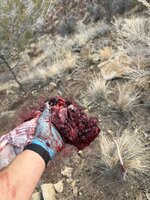Not trying to be difficult here, but also not getting the nuance you are referring to. I used monos for about 15 years and then switched back to lead. Have lots of experience with them but have not used every option. From what I’ve seen, the only non-lead option that comes close to doing what lead bullets do is the DRT. I don’t have a ton of experience with them yet, and have heard some reports of inconsistencies.I think your opinions and feelings are preventing you from understanding the nuance of this discussion. I am not speaking in absolutes, you are.
Yes reasons are based on facts and data, you just failed to appreciate that "large volume would channels across a wide range of impact velocities" is not ALWAYS the needed result. Hence your absolute statement was flawed. Is it a more versatile result for a wide range of scenarios? Certainly. But we aren't always limited to one option for every single hunting shot and situation. Personally I have a mono load and a ELDM load for a given rifle, I can use whichever suits my preference and the scenario.
I too would avoid barnes below 2100fps, not sure about some of the others yet.
Example: why if shooting a pronghorn in a wide open field at a range that allowed a mono to impact with ample velocity and conditions/shooter that allowed excellent bullet placement would one have to have a large volume wound channel? FACTS / DATA: They aren't a tough animal to kill, they don't need a big wound, those conditions don't create a worry about loosing track of them assuming they don't just drop right there.
That doesn't mean a "large volume would channels across a wide range of impact velocities" is inappropriate for the above scenario, it just isn't the only solution to the situation that will result in a promptly killed and retrieved animal.
But here is the nuance on copper alloy monos based on my experience.
The primary reason people tend to use these is concern over lead toxicity. That is a politically charged topic that I would prefer not to see derail this thread. There is no published evidence that eating game killed with lead affects the blood lead levels, but there are lots of other things that do affect those levels. I will leave this issue here.
People generally tout penetration as a primary factor for why they should use monos, but I’ve yet to experience A situation where I have not had sufficient penetration to kill an animal with lead bullets. I have experienced multiple occasions where non-lead bullets have failed to exit deer and elk, even on broadside shots. So my personal experience on this is it that it’s a moot point.
With respect to the wound channels. Death is caused by damage to tissues. More damage means higher incapacitation rates, shorter distance traveled post shot, and higher recovery rates. A larger wound channel also means a higher probability that it intersects with critical organs and blood vessels. That means minor variability in shot placement has less effect on incapacitation rates. Monos don’t do any of that better than something like an eldm.
But people complain that fragmenting bullets destroy too much meat. Those same people mostly shoot shoulders and high shoulder shots. They generally do this because they want to “anchor” the animal and reduce post-shot travel and tracking. This is a circular argument. They are choosing a shot location that impacts more meat to kill an animal quicker with a bullet that makes less damage. If you use a bullet that makes more damage, shoulder shots aren’t as important. But complaining the same bullet does to much damage with a shoulder shot makes no sense.
To get larger wound channels with monos you have to shoot larger projectiles faster than lead projectiles. That means increased recoil and decreased accuracy which also corresponds to decreased incapacitation rates, longer post-shot travel and decreased recovery rates. Again, no benefit to monos.
Monos are more velocity-sensitive which means you have to limit your maximum range. The ballistic tipped fragmenting bullets discussed commonly here perform well down to 1800 and some down to 1600 fps impact velocity. I am not aware of a moon that performs well below 200 fps impacts, and the ones I’ve used worked way better at 2200. I think this is one of the least important factors because most people shouldn’t be shooting game far enough to make the difference worth while. That said it’s still an edge to the lead bullets.
Monos also tend to have significantly lower BCs. Much of this is related to the density of the material, so there really isn’t a way to improve it. You end up with longer bullets for a given mass which also makes them more sensitive barrel twist and less stable. Many of the monos you mentioned also have questionable BC values reported by the manufacturer. Again most people shouldn’t be shooting far enough for any of this to matter to make this matter much. But no benefit for using monos.
And there’s cost. Monos are more expensive to manufacture and may are made by small boutique manufacturers. They are more expensive across the board. Many are a handload proposition only. Again, no advantage.
Can you kill stuff with them? Yes, I’ve killed a lot of stuff with them. But aside from being legally required to use them, I cannot come up with a single reason to choose to use them over a good fragmenting lead bullet. If you like them, that’s great. But I personally wouldn’t advise someone to use them unless they are required to do so.


